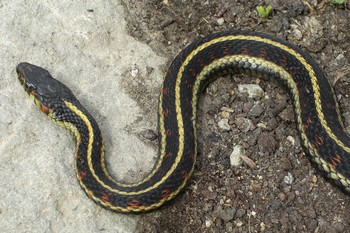Reptiles and Amphibian
 Garter Snake |
Wells Gray is not big on reptiles and amphibians. Of snakes and lizards, the park has a meagre three species (or possibly now only two), and of frogs, toads and salamanders, the totals are three, one, and one, respectively. These figures translate to about 0.05% of the world’s reptiles, and 0.2% of its amphibians.
Reptiles and amphibians are ectotherms, that is, they are unable to produce their own body heat (different from birds and mammals), and must make do with whatever warmth they can soak up from their immediate environment. When outside temperatures are cool, they become sluggish. When the thermometer drops to freezing, they must either escape to a warmer place underground, or else they die.
The herptile’s answer to winter is hibernation. Even so, there are limits to how long a body can stay curled up underground. Even in the valley, snow persists for about five months of every year, whereas at treeline it may linger some four months longer.
When a herptile finally rouses from its winter sleep, it needs heat and suitable habitat in order to perform the vital functions of feeding, reproducing, and avoiding being eaten. Wells Gray is just not warm enough for most amphibians and reptiles to cram all that living into the short period between winters.
Most reptiles and amphibians keep to the lowlands. The snakes primarily inhabit warm, south- or southwest-facing sites below about 1000 m. Here they can be found basking in the sun as early as April and as late as October. Look for the Common Garter Snake in open meadows and forest edges. The Ray Farm and the Dragon’s Tongue are good places to see them. The Terrestrial Garter Snake, by contrast, is more common near water.
It should be noted that neither of Wells Gray’s snakes makes a living eating people. Nor are they in the least venomous. Their prey consists of earthworms, insects, rodents, small fish, frogs and toads. Enjoy.
Only the amphibians make it to treeline. One of these, the Spotted Frog, can be found in small lakes to about 2000 m, whereas another, the Western Toad, occurs virtually throughout, sometimes wandering to the mountain peaks.
The Pacific Treefrog and the Northern Alligator Lizard are both near the northern edge of their range here. The former species is most easily seen among the broken rocks of the Dragon’s Tongue. The latter may no longer occur in the park, though it does thrive on some south-facing slopes near Clearwater. The Rubber Boa has also been reported from the Birch Island area.
| Reptiles & Amphibians of Wells Gray Park | ||||||
VIEWING STATUS: (in appropriate habitat):
|
||||||
| Common Name | Status | Scientific Name | ||||
| Northern Alligator Lizard | ? | Elgeria coerulea | ||||
| Common Garter Snake | ** | Thamnophis sirtalis | ||||
| Western Terrestrial Garter Snake | • | Thamnophis elegans | ||||
| Western Spotted Frog | ** | Rana pretiosa | ||||
| Wood Frog | • | Rana sylvatica | ||||
| Long-Toed Salamander | • | Ambystoma macrodactylum | ||||
| Western Toad | *** | Bufo boreas | ||||
| Pacific Tree-Frog | ** | Hyla regilla | ||||
Text extracted, with partial updates, from the 2nd edition of Nature Wells Gray: A Visitors’ Guide to the Park, by Trevor Goward & Cathie Hickson © 1995, for several years out of print, and now awaiting sponsorship toward a third, much improved edition.

 Nature Wells Gray
Nature Wells Gray 

